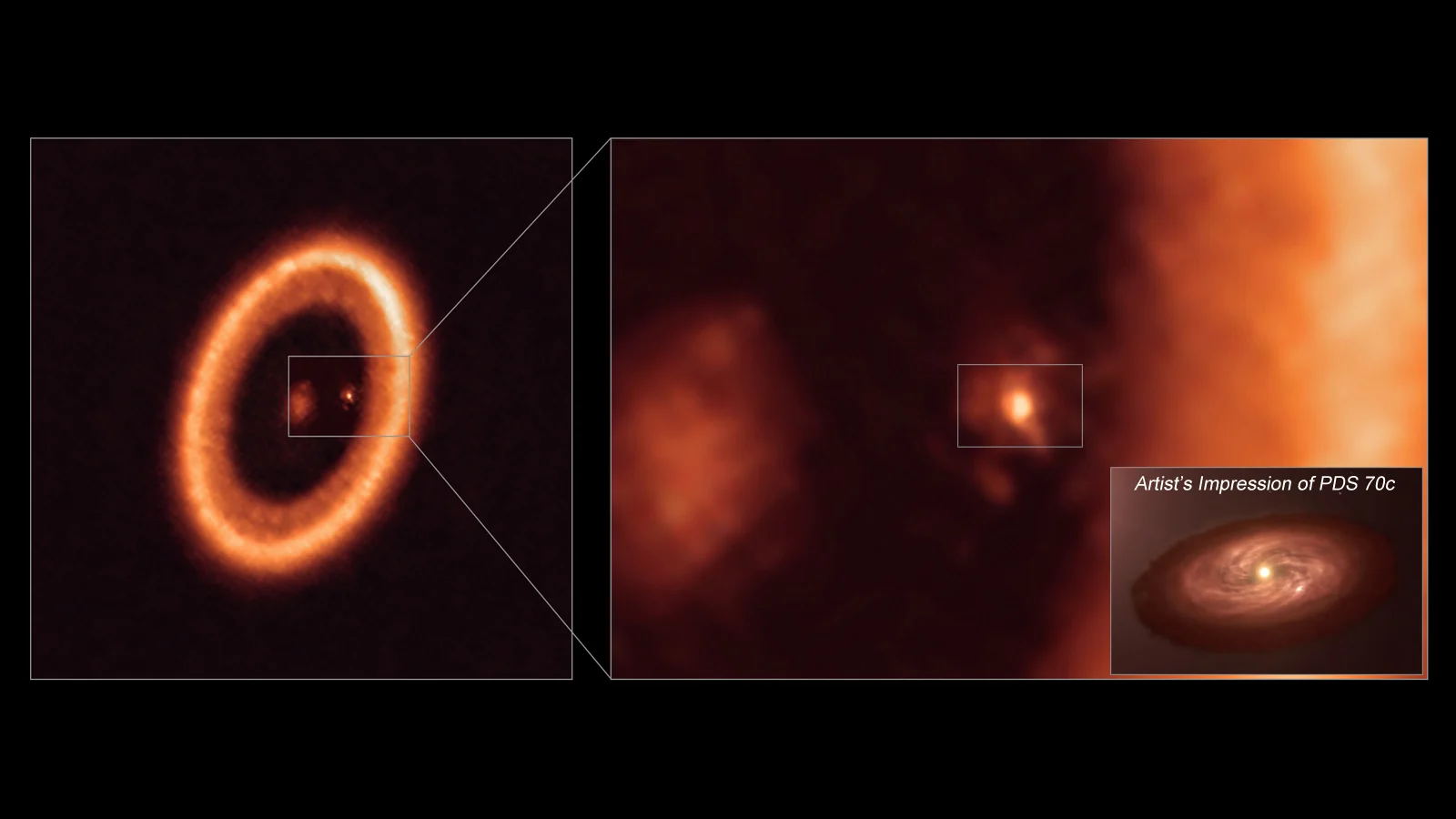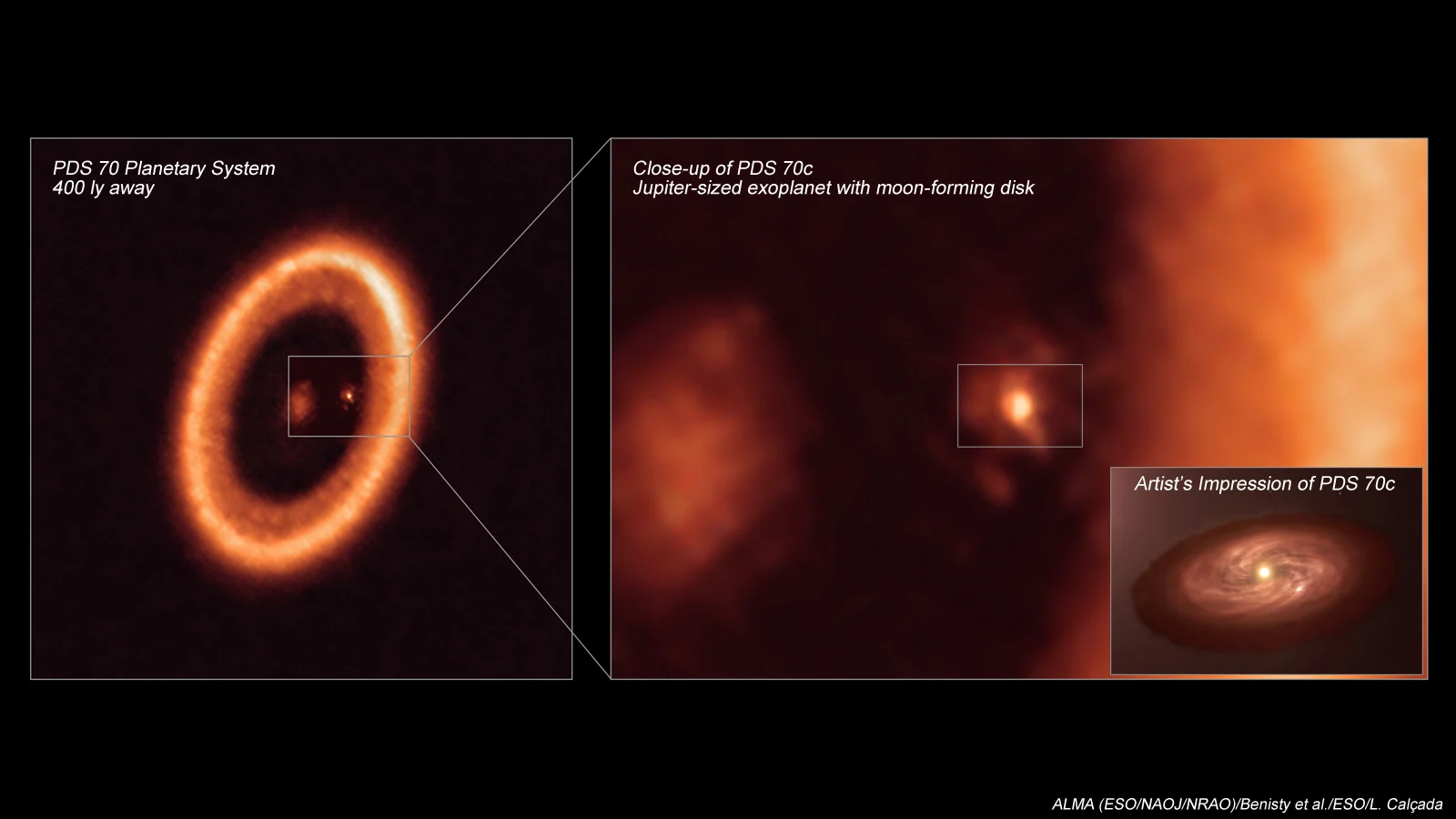
Astronomers detect alien moons being born in a distant planetary system
After years of searching for elusive 'exomoons', astronomers have discovered a planetary nursery that looks to be forming several of them.
Using an array of powerful radio telescopes high in the desert mountains of northern Chile, astronomers have confirmed the first discovery of alien exomoons.
In our own solar system, there are over two hundred known moons. Earth's solitary Moon shines in our night sky regularly, and we know from telescopes and spacecraft that moonless planets are the exception here, rather than the rule. Of the eight major planets, only Mercury and Venus have no natural satellites. Meanwhile, the gas giants have collections! We've spotted 14 around Neptune, Uranus has at least 27, and Jupiter and Saturn seem to be in a competition to see who has the most (currently, Saturn is winning with 82, over Jupiter's 79). Even binary dwarf planet pair Pluto and Charon have four common moons of their own.
Gazing out into the galaxy, we have evidence of thousands of exoplanets orbiting other stars so far. Estimates put their numbers in the millions. However, up until now, we had yet to find conclusive evidence of any exomoons orbiting those exoplanets. Part of the reason for this is their small size relative to their host planet. Thus, even an Earth-sized moon orbiting an immense gas giant would still remain hidden to us from light years away.
Two years ago, while examining a young star named PDS 70, around 400 light years away, astronomers found two exoplanets there. They were very similar to Jupiter and Saturn, but they were still in the process of forming. The images they gathered weren't sharp enough to tell for sure. However, they thought that at least one of these alien gas giants may be surrounded by a belt of moon-forming material known as a circumplanetary disk.
According to the European Southern Observatory (ESO): "Planets form in dusty discs around young stars, carving out cavities as they gobble up material from this circumstellar disc to grow. In this process, a planet can acquire its own circumplanetary disc, which contributes to the growth of the planet by regulating the amount of material falling onto it. At the same time, the gas and dust in the circumplanetary disc can come together into progressively larger bodies through multiple collisions, ultimately leading to the birth of moons."
In a new study, a team of astronomers used ALMA, the Atacama Large Millimeter/submillimeter Array, to more closely examine this baby exoplanet, named PDS 70c. Their new observations resolved the protoplanet well enough that they could confirm there really is a disk of moon-forming material swirling around it.

The ALMA image of the PDS 70 planetary system is shown to the right. The innermost planet (PDS 70b) is not visible here. Still, PDS 70c stands out as a bright dot just inside the cavity it helped carve in the system's circumstellar disk (the bright ring around the entire system). A zoomed-in view of PDS 70c is also presented. For perspective, the inset image shows an artist's impression of the gas giant exoplanet and its moon-forming ring. Credit: ALMA (ESO/NAOJ/NRAO)/Benisty et al./ESO/L. Calçada
"Our work presents a clear detection of a disc in which satellites could be forming," lead author Myriam Benisty, from the University of Grenoble, France, and the University of Chile, said in an ESO press release. "Our ALMA observations were obtained at such exquisite resolution that we could clearly identify that the disc is associated with the planet and we are able to constrain its size for the first time."
According to their research, the moon-forming disk surrounding PDS 70c is about 150 million kilometres wide. That's the same as the average distance between Earth and the Sun, and over 550 times the size of Saturn's rings. Furthermore, their observations showed that the material in the disk looks to be enough to form three satellites roughly the same size as our Moon.
"More than 4,000 exoplanets have been found until now, but all of them were detected in mature systems," explains study co-author Miriam Keppler, who is a researcher at the Max Planck Institute for Astronomy. "PDS 70b and PDS 70c, which form a system reminiscent of the Jupiter-Saturn pair, are the only two exoplanets detected so far that are still in the process of being formed."
The young age of these planets actually helped with this exomoon detection.
In a more mature planetary system, any circumplanetary disks have already been swept up by the moons they are forming. The resulting satellites would be too small compared to their planet to pick up. With PDS 70c, though, the immense size of its circumplanetary disk allowed astronomers to pick it up, even from 400 light years away.
"This system therefore offers us a unique opportunity to observe and study the processes of planet and satellite formation," added co-author Stefano Facchini, a Research Fellow with the ESO in Germany.






